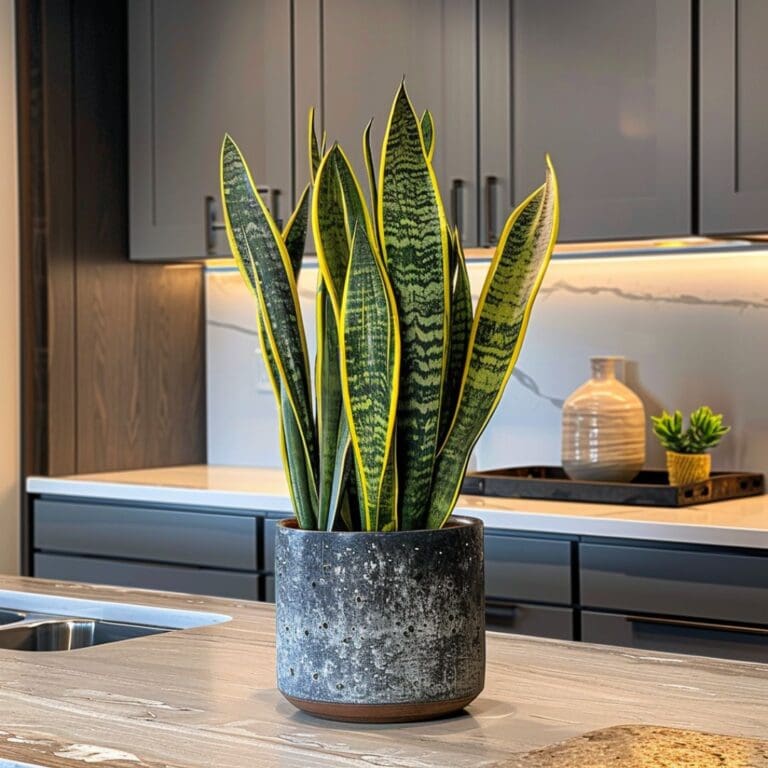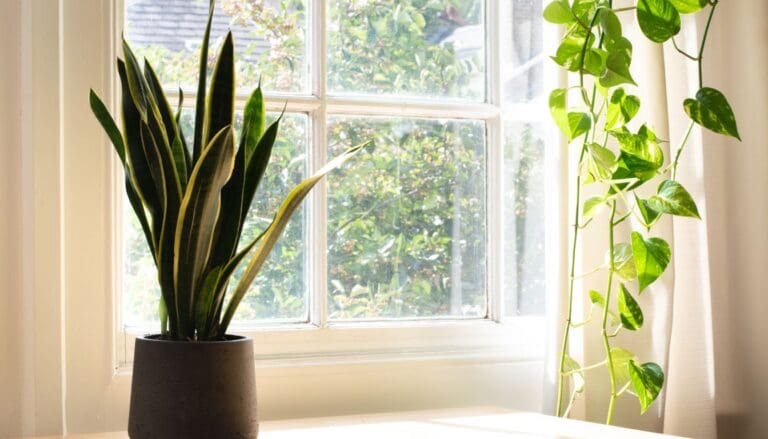Healthy Vs. Unhealthy Snake Plant: Signs To Note
One of the hardiest and most loved houseplants in recent years has to be snake plants. With long slender upright leaves, these plants are not just gorgeous but purify the air too.
The leaves of a healthy snake plant are upright and rigid, not soft or saggy. Depending on the variant of the plant, the colors should be sharp and pristine alternating between yellow, dark green, or light green. Brown spots in the plant’s leaves indicate a problem.
In this article, I will talk extensively about the various signs on your snake plant that exhibit its health conditions, so that plant owners find it easier to know their plants.

Please note: Simplify Plants is reader-supported. Some links in the post are affiliate links and I get a commission from purchases made through links in the post.
Signs of a healthy snake plant
Belonging to the southern regions of Africa, snake plants have gotten popular all across the world.
In USDA regions 8 and through, they are grown all year outdoors.
Here are some signs of a healthy snake plant:
1. Upright leaves
The leaves of snake plants are famous for their sharp firm body that grows upright from the soil.
The leaves have different heights and sizes depending on the plant’s species.
Some species, like Hahnii and Kirkii, have leaves that curve, while some, like Boncel, have leaves that spread like a rosette.
Though the height may be different, what is common in all the species is the strong, firm leaves that have no sagginess in them.
2. Full and firm appearance
Snake plants in nature grow in arid deserted regions of the world.
Thus, they are made by nature so that they can store water inside them.
So, the leaves of this plant have a full, fleshy appearance and are plump and smooth.
A dehydrated snake plant can have wrinkled, dull leaves.
It is important to understand how much and when you should water them.
Too frequent watering can ruin them, but too little watering can make them dry.
Use a potting mix suitable for succulent plants, which have excellent drainage and stay loose and airy so that it does not hold excess water.
3. Bold coloration
A healthy growing snake plant should have vivid contrasting leaves.
4. Clear surface
A healthy plant should have smooth, clear skin.
If there are spots, blotches, or bumpy areas on the body, that can signify a problem.
5. New growth

When the plant is happy and healthy, it should gift you new healthy leaves, which are miniature versions of the mature leaves.
They are initially lighter in color, and as they grow, they darken over time.
This new growth appears just a few inches away from the existing leaves or right at the edge of the leaves.
These pups are the sign of a happy, healthy plant that reproduces by shooting out new rhizomes.
Signs of an unhealthy snake plant
Despite being a strong and bold plant, unfortunately, many things can still go wrong with this plant.
But luckily, most of them are easy to fix once you identify the problems and take the necessary treatments.
1. Bending or drooping leaves
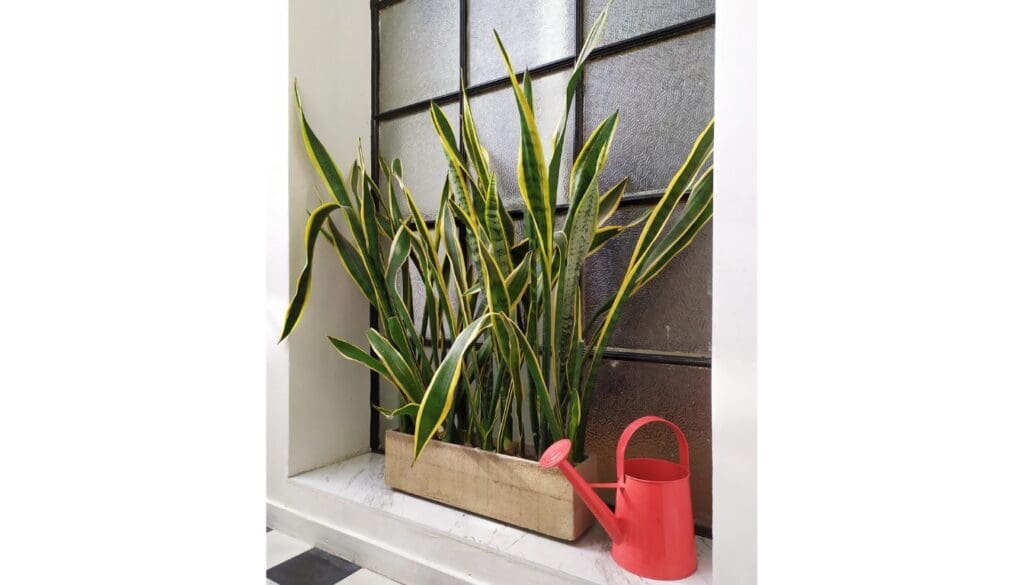
The leaves of Sansevieria are strong and upright, giving them elegant appeal, but droopy leaves can signify multiple problems.
The thick leaves of the plant store water in them, which is why they can live without water for days.
If you find the leaves of your snake plant are droopy and bending instead of growing upright, it might indicate that you have been watering the plant more than required, and it has caused root rot at the base of the plant.
Overwatering is a disease that rotten the root system by cutting off oxygen and saturating the roots with water.
They cannot transport nutrients and food to the plant, ultimately killing it.
Along with the droopy leaves, you may also experience a bad odor from the soil as the fungus sets in.
Another reason for droopy leaves can also be due to temperature fluctuation or cold shock.
Being warmth-loving plants, they do not like extremely cold temperatures.
It can send the plant in a shock if temperatures hit below 50°F.
Snake plants are loved for their strong sword-like leaves, which have also given them the name mother in laws tongue.
The leaves are supposed to grow straight upwards firmly from the ground.
If they do not and start to sag, droop, or bend, you need to check the plant’s health.
Reasons for this could be incorrect light, poor soil and wrong watering, and too much humidity.
2. Spots and blotches
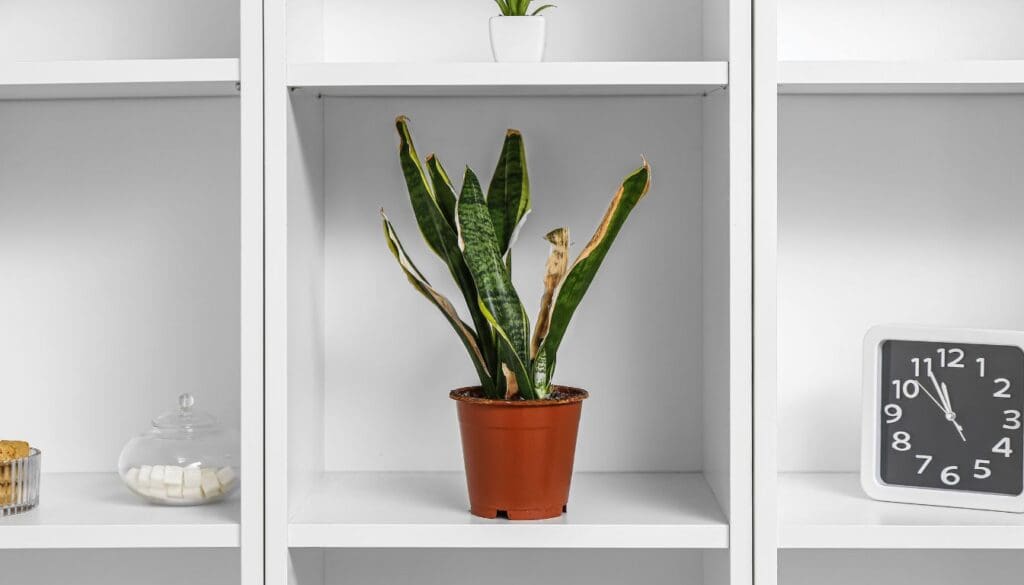
The glossy leaves of your snake plant can develop spots, and marks on them can signify ill health.
If the plant is exposed to too much harsh direct sunlight, it may cause sunburn on them.
This may cause yellow and brown spots on them as they tend to dry the plant’s tissues.
Sometimes pest attacks like spider mites and thrips may cause tiny pale dots on the foliage.
Sometimes pests like scales create raised bumps on the leaves that are immobile, brow, or grey.
Mealybugs may create white waxy cottony spots on the plant that gradually suck out the nutrients from the plant.
3. No or slow growth

Snake plants are slow-growing, but you should keep an eye on the height of the plant.
Those that grow in pots should have mature leaves three inches wide and 6-8 feet in height.
If you notice that your plant has not been growing at all, this might be a sign of serious concern.
Stunted growth can be due to problems like poor nutrients, low light availability, poor soil, pest attacks that silently feed the plant’s nutrients, and so on.
Sometimes if the plant is too root-bound and there is no space in the pot to grow, the plant’s growth also reduces.
If you can find out and identify the cause of the problem, you can treat the plant easily and amend the problem.
The plant should grow two to four new leaves every year and add up to six inches in height.
If your plant is not growing as it should, you should pay attention to its health.
Incorrect watering, poor light conditions, and insufficient nutrients can slow the plant’s growth.
You must note that though these plants can tolerate low lights, their best growth occurs in bright light.
A plant grown in lower light will grow slower than the ones grown in bright light.
4. Brown tips of leaves
Brown tips on snake plants can indicate many problems.
One of them can be physical damage which may cause injury to the plant.
The next reason for brown tips can be temperature fluctuations.
Too much cold and too much sunlight can result in this problem.
Poor nutrients can also lead to brown tips on the leaves.
5. Dull pale leaves
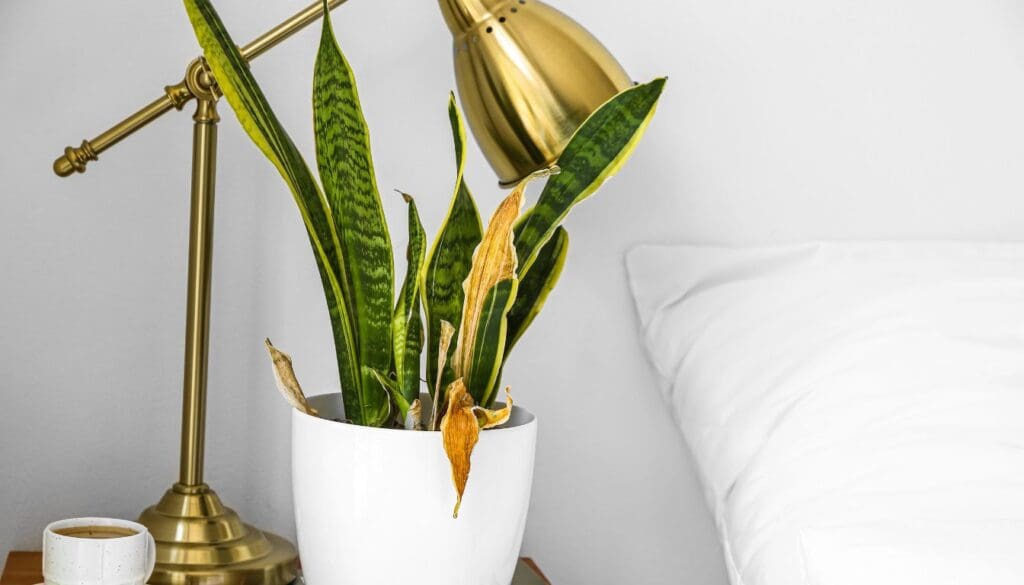
Always keep an eye on the color of your snake plant.
The foliage of these plants is dark and bright. Whatever variegations your plant has, the colors must be deep.
If you notice the color of the foliage turning pale, it must be noted, and you should take action to determine the causes.
If your snake plant appears to have pale leaves or the green parts look dull, your plant may require some nutrients.
Nutritional deficiency in your plants can make them look dull and force the plant to lose their bright glossy colors.
Another reason for dull leaves can also be low lights.
If the plant does not get enough sunlight, it may lose its brightness and look dull.
Low sunlight also forces the plant to lose its variegated leaves, turning the bright yellow hues dull green.
Three reasons that can turn the foliage pale are:
- Nutritional deficiencies: The leaves of this plant can begin to fade if it lacks nutrients, especially potassium. To treat this condition, you need to feed it with a balanced fertilizer to give it the necessary nutrients.
- Overwatering: Being a succulent, overwatering is the leading cause of death. The strong fleshy leaves hold a lot of water in them, so their water intake is very low. If you constantly overwater your plants, they can turn paler.
- Overexposure to light: Your snake plant can also turn pale if exposed to too much direct strong sunlight. Too much sunlight tends to bleach the leaves of your plant, turning them pale. The ideal light condition is bright indirect light.
6. The wrinkled texture of leaves
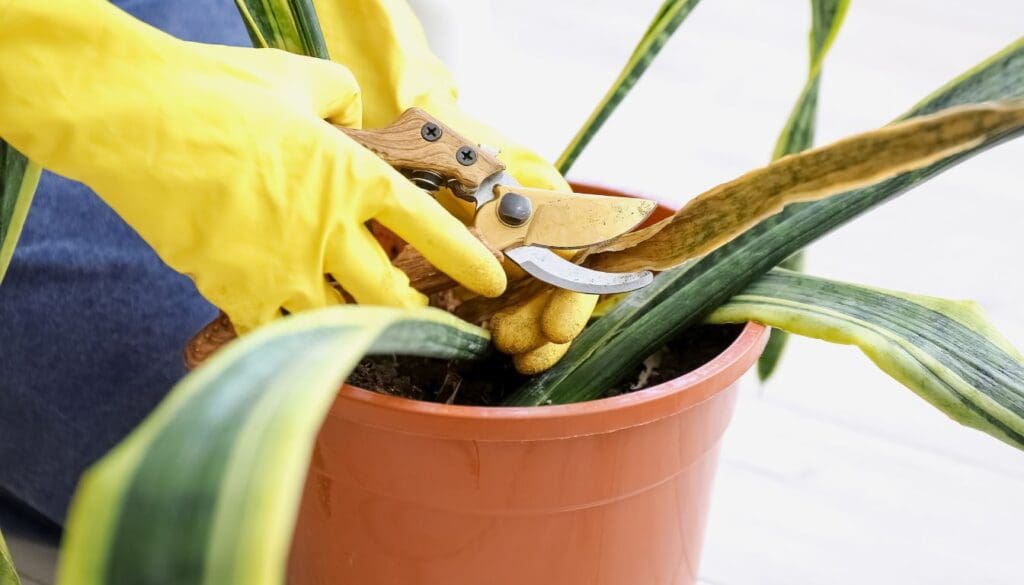
As I discussed above, the leaves of snake plants are smooth and fleshy.
If the leaves of your plant look wrinkled and crisp, your plant might need water immediately.
Though you should not be touching or playing with the plants often, for snake plants, if you suspect there is a concern with the plant, you should touch it to feel the texture.
The leaves of these plants are firm and are not supposed to be soft or brittle.
If the leaves feel crispy, dehydration can be one of the causes, and if you feel the leaves have lost is firmness and feel mushy, then overwatering might be one of the issues, or it might be any disease like southern blight.
It is a type of disease caused by a fungus attacking the plant and feeding the nutrients inside it.
It is a very dangerous disease and can kill the plant within days if not checked.
If your plant suffers from this disease, use fungicide or methyl bromide to treat it.
Sometimes over-fertilization can also burn the plant and cause crispy tips and brown edges of the leaves.
Excessive heat can also cause wrinkled leaves on your snake plant.
7. Mushy leaves

Mushy soft leaves are a sign your plant is getting too much water, resulting in too much water inside the plant.
The leaves gradually turn limp, and the entire plant dies as the rot progresses.
It is important that this plant’s soil does not hold excess water and has good drainage.
For this, adding elements like perlite and sand helps to keep the soil’s drainage.
Besides watering, excessive humidity can also cause mushy leaves on your plants.
8. Mushy roots

If you notice the roots of your snake plant have turned mushy and brown, you must repot the plant immediately.
Treatments
Here are a few things you must try:
1. Fingertip test
Poke your finger inside the soil to see the moisture content and quality.
If the soil is wet, avoid watering the plant until it is dry.
Snake plants do not need much water; you must let the soil dry in between watering.
If you find the soil clumpy and tight, you must change it and amend it to make it lighter and airy.
To improve the soil quality, add organic elements to improve drainage.
Sand, perlite, charcoal, vermiculite, compost, etc., improves the soil texture and makes it richer and breathable.
2. Inspect the root ball

If you suspect any diseases or rotting in the root of the plant, then you need to take the plant out of the pit and check the root ball thoroughly.
Healthy roots should be white and crisp.
It has succumbed to rot if you see it soggy, black, and smelly.
Root rot occurs when the roots are unable to breathe due to waterlogging.
The roots are attacked by pathogens that cause rotting in the plant.
In case of that, here is what you should be doing:
- Wash the root under running water.
- Prune off all the decayed mushy roots.
- Prepare a fresh soil mix that has excellent drainage and is light.
- Repot the plant in a fresh container with this soil mix.
Care tips for snake plants
- Snake plants enjoy indirect bright light for partial sun. Keep them from direct sunlight if your region has very hot summers.
- Use well-draining soil for a snake plant. Since they come from arid regions, their soil needs to be on the sandier side, not clayey. Using cactus or succulent mixes can be a good option for them.
- Let the soil completely dry off in between watering. They are drought-tolerant plants and do not need much water as they already have water inside them.
- Do not expose the plant to temperatures below 50°F as they dislike cold weather.
- Feed them with all-purpose liquid fertilizer during the spring.
Final words
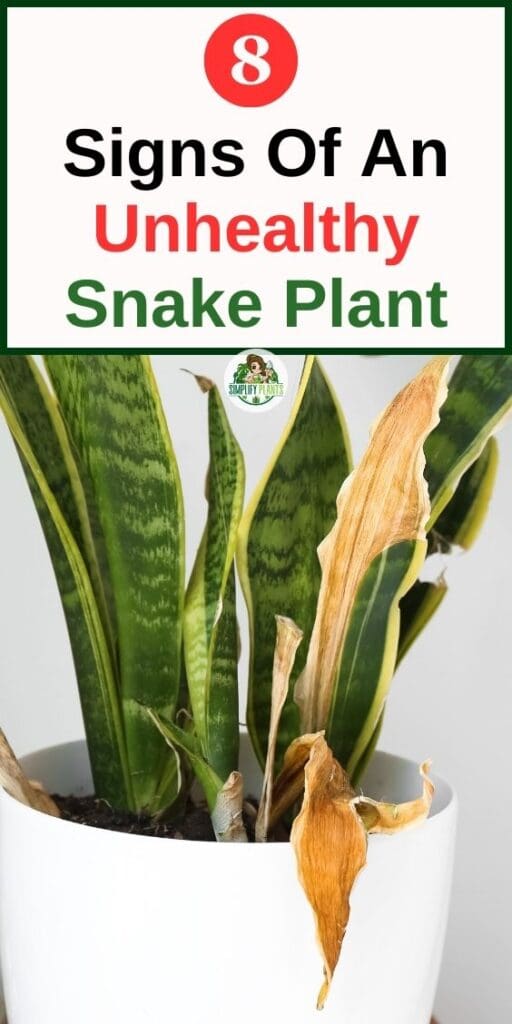
Snake plants are one of the easiest plants to grow indoors and are loved for their easy, lush, elegant look. If you notice any sign of a problem on your plant, it is recommended that you take action at the earliest.
Keep an eye on the health and growth of your plant to catch the warning signs at the earliest. Now that I have discussed the different warning signs and their treatments, we hope you can grow your happy and healthy snake plant.
Source: The University of Arkansas Division of Agriculture, University of Minnesota, Snake plant profile.
Recommended Garden Supplies
| Product Image | Our Recommended Gardening Supplies | Check Offers! |
|---|---|---|
Top Top
Top
Top
Top
Top
Top
Top
Top | rePotme Houseplant and Tropical Classic Potting Soil Mix | Check Offer On Amazon |
 Top
Top
Top
Top
Top
Top
Top
Top | Espoma Organic Indoor Plant Food | Check Offer On Amazon |
 Top
Top
Top
Top
Top
Top
Top
Top | GooingTop LED Grow Light 6000K Full Spectrum Clip Plant Growing Lamp | Check Offer On Amazon |
 Top
Top
Top
Top
Top
Top
Top
Top | Soil Moisture Meter | Check Offer On Amazon |
 Top
Top
Top
Top
Top
Top
Top
Top | Govee Hygrometer Thermometer, Bluetooth Enabled! | Check Offer On Amazon |
 Top
Top | LEVOIT Humidifiers for Large Room(Best For Plants) | Check Offer On Amazon |
 Top
Top
Top
Top
Top
Top
Top
Top | Upgraded DIY Automatic Drip Irrigation Kit, 15 Potted Houseplants Support | Check Offer On Amazon |
 Top
Top
Top
Top
Top
Top
Top
Top | Stainless Steel Heavy Duty Gardening Tool Set | Check Offer On Amazon |
 Top
Top
Top
Top
Top
Top
Top
Top | Bonide Insecticidal Soap | Check Offer On Amazon |
 Top
Top
Top
Top
Top
Top
Top
Top | Bonide 32 oz Spray Neem Oil for Organic Gardening | Check Offer On Amazon |
 Top
Top
Top
Top
Top
Top
Top
Top | Garden Safe Fungicide | Check Offer On Amazon |

